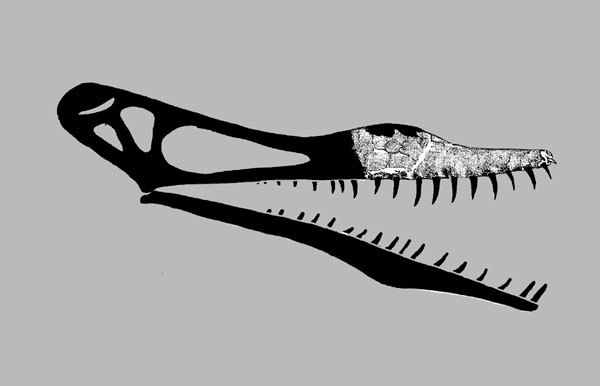Genus: Cimoliopterus RODRIGUES & KELLNER, 2013
Etymology: Greek, kimolia, "chalk"
and Greek, pteron, "wing."
Species: cuvieri (BOWERBANK, 1851) RODRIGUES & KELLNER, 2013
= Pterodactylus cuvieri BOWERBANK, 1851
= Coloborhynchus cuvieri (BOWERBANK, 1851) OWEN,
1874
= Ornithocheirus cuvieri (BOWERBANK, 1851)
SEELEY, 1870
= Ornithochirus cuvieri (BOWERBANK, 1851) LYDEKKER, 1888 (sic)
= Ptenodactylus cuvieri (BOWERBANK, 1851) SEELEY,
1869
= Anhanguera cuvieri (BOWERBANK, 1851) UNWIN, LU & BAKHURINA,
2000
Etymology: Etymology: In honor of Georges Cuvier, a world renowned paleontologist
(1769-1832).
= Genus: Nova RIDRIGUES & KELLNER, 2011
Holotype: NHMUK PV (old BMNH) 39409
Locality: Culand Pits, Burham, (TQ 738617), Kent County, England, Southern United Kingdom.
Horizon: Cambridge Greensand (originally Lower Chalk-Upper Chalk).
Biostratigraphy:
Age: Cenomanian-Turonian Stage, Upper Gallic Subepoch, Lower Gulf Epoch, Middle-Late Cretaceous.
Material: Premaxilla.


Referred material:
NR 41637: Wing phalanges.
SEELEY, 1870
Sedgwick Museum 113: Premaxillae.
UNWIN, 2001
CAMSM B54.431: Anterior end of a rostrum. Left; Left lateral view; Right; ventral view.
LYDEKKER, 1888
Locality: Halling, Kent County, England, Southern United Kingdom.
Horizon: Lower Chalk.
Biostratigraphy:
Age: Early Cretaceous.
Material:
BMNH 37982: Fragmentary tooth.
OWEN, 1861
Locality: Kent County, England, Southern United Kingdom.
Horizon: "White chalk".
Biostratigraphy:
Age: Early Cretaceous.
Material:
Sedgwick Museum: Proximal end of a humerus.
= Ornithocheirus brachyrhinus (SEELEY, 1869) SEELEY, 1870 (nomen dubium)
= Ptenodactylus brachyrhinus SEELEY, 1869 (nomen dubium)
Etymology: Greek, brachys, “short” and Greek, rhinus, “the nose.”Holotype: CAMSM B54443 (old Woodwardian Museum.)
Locality: Cambridge, Cambridgeshire County, England, Southern United Kingdom.
Horizon: Upper Cambridge Greensand.
Biostratigraphy:
Age: Albian Stage, Middle Gallic Subepoch, Upper Early Cretaceous Epoch, Middle Cretaceous.
Material: A fragment of premaxilla.
_____________________________________________________________________________________
Species: dunni MYERS, 2015
Etymology: In honor of the discoverer Brent Dunn.
Holotype: SMU 76892
Locality: SMU locality 518, near Lewisville Lake, southwest Denton County, Texas.
Horizon: Britton Formation, Eagle Ford Group.
Biostratigraphy:
Age: Upper Cenomanian Stage, Middle Gallic Subepoch, Lower Gulf Epoch, Middle Cretaceous.
Material: Partial rostrum.